Memories of Dredmor, part 1
This is a subjective telling of the story of the formation of Gaslamp Games and development of Dungeons of Dredmor which was released ten years ago on July 13, 2011.
Dredmor would go on to become an indie game success story and even given an "Indie Game of the Year" award by PC Gamer magazine. Gaslamp would release three expansion packs for Dredmor before beginning production on a new game, Clockwork Empires, starting in 2012 and in earnest in 2013. The project didn't go well, to say the least, and Gaslamp Games shut down operations by the end of November 2016.
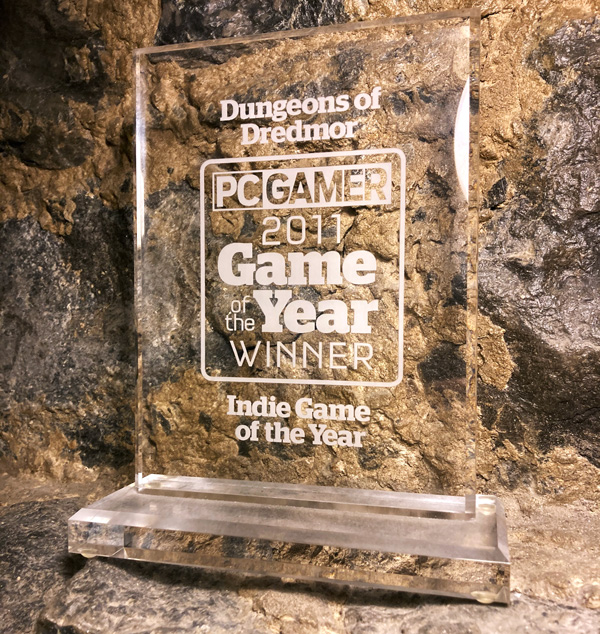
My memory is not perfect and it is necessarily focused on myself, so do not consider this a comprehensive or objective history. Some of these events are going to be out of order and otherwise patchy, though I will try to place them in context as best I can and describe them in the spirit that I remember them.
This is going to be my story, and I'm writing it without any particular oversight by Gaslamp Games as an entity or the other two partners who formed that company with me. I want to specifically claim this narrative for myself because through my time at Gaslamp my particular contributions, aside from my art, tended to be subsumed into the collective identity of the company. (Which we'll get into - and more, of course.)
For fans of Gaslamp Gaslamp, maybe you'll get a little better idea of everything that was going on in those few crazy years that produced Dredmor; I'll try to include images and details that haven't been made public. For those looking to get into game development, maybe there's some useful advice and dire warnings, though that'll all be nearly 15 years out of date. For train-wreck sightseers - this isn't quite about that. But rest assured, Mistakes Will Be Made.
We begin in the year 2007.
In which I become a Professional Game Artist
I was, and still am, an American living in Canada. I graduated from the Alberta College of Art & Design (now called "Alberta University of the Arts") with a degree in something called "Media Arts" in 2007. That July, my partner and I moved from Calgary, Alberta to Victoria, British Columbia, staying at her parents' place while figuring out our living situation. Technically my student visa had run out by this point, though I had submitted paperwork to become a permanent resident of Canada, so I was in a bit of a legal gray zone when it came to employment and renting an apartment. (Immigration Canada did eventually backdate my legal status to cover this period at a later point, which was very nice of them.)
In the meantime, I had to figure out what to do with myself. The notion of work would be quasi-legal at best for a while, so I started by dedicated myself to learning to code and otherwise attempting to hone my feeble digital art skills. I had created an account on the website gamedev.net while in school, inspired by a guy I was friends with at ACAD who wrote his own 3D engine (in C, while attending art school; no, I don't know quite what he was doing there either). And it was through gamedev.net that I first found the opportunity to work as a freelance artist for games.
The trick, you see, is to hang out where you're the only artist among a bunch of programmers. They have no idea how to art, and no idea what's any good, so even if you're not very good (and I was not) you're still going to be a whole lot better than nothing at all. Who better to draw your sprites and icons but the one artist that's around?
I received my first payment in December of 2007, a check in the mail for around $100. Which means that as of this writing I've technically been "a professional" in the games industry for nearly 14 years.
I would continue to work on a huge number of small games, often browser-based or mobile, and most of them failed projects, up until the month before Dungeons of Dredmor released on Steam. This provided me with valuable practice, experience, perspective, and best of all money.
Some yahoos working out of a basement need an artist
It was in the summer of 2008 that the band got together for the first time.
A friend of mine, Nate, who happened to be LiveJournal-friends with Nicholas Vining saw him post that he needed "an animator" for "his game company", or something to that effect. Nate forwarded contact info and emails were exchanged.
I was not actually much of an animator. Also, Nicholas did not actually have a game company. (Also, from how he tells it, Daniel assumed that he was in an equal partnership with Nicholas and Jesse - wait, who? - from the get-go, and I was supposed to simply be a contract artist).
So clearly everything was fine, organized, and expectations clearly communicated. Obviously.
I first met Nicholas and Daniel and Jesse at a Starbucks - or was it a Blenz? - coffee shop in downtown Victoria. Daniel Jacobsen was a university friend of Nicholas' younger brother Richard, a year and a half younger than Nicholas and myself - and I wasn't more than 23-24 at the time. They pulled out a laptop to show off their tech demo of ... no, not Dungeons of Dredmor, but a game that was basically Final Fantasy Tactics but - get this - steampunk! With a 3D landscape! And it had vaguely simulated dynamic volumetric liquid technology? This game was called Clockwork Fantasia.
(Those who know how this story ends see echoes from the future already reaching back in time.)
This was all very impressive. They asked perfunctory questions, I expressed generic enthusiasm and social awkwardness. After a bit of a perfunctory follow-up I "got the job". I was super excited by getting "a job". This was not a real job, of course, but rather a personal contract with Nicholas. The deal was this: he'd pay me $1000 once I completed drawing a big list of animated characters for this game.
I never did get that $1000. I never did finish that list of animated characters, so fair enough.
So wait, this isn't Dredmor at all. What happened?
Clockwork Fantasia
Remember, at this time there was no Gaslamp Games, inc. There was no legal entity developing this product. (There are a series of complex stories here about the lineage of the IP and technology involved from well before my time, but they aren't mine to tell, so I'll leave it at what I knew then, which was very little.)
What we had was an enthusiastic and very, very poorly organized effort to align the output of several different people into, more or less, A Direction. No one had legitimate professional experience in the development of actual software, project management ability, or management experience. ( -- Yes, Nicholas would make much of working for some small game companies in his teens, but I would contend that those were both exploitative and horrendously managed businesses from which no positive lessons could or should be gleaned. Dire portents only.)
... They did have an office though.
Well, sort-of. This office was Nicholas' father's renovated basement in Esquimalt, the suburb directly adjacent to downtown Victoria across the harbour bridge. It was set off from the other half of the basement which was less finished and reeked of epoxy from Daniel and Richard's abortive project to craft a Mega Man arm-gun cosplay piece for their trip to Penny Arcade Expo. The office was gloomy, wood paneled, and one column in the center inexplicably wrapped in something that resembled pleather. We'd call it "the German bondange dungeon", and it inspired the wood tileset you may recall from Dungeons of Dredmor. The furniture was a collection of old tables and chairs apparently purchased as surplus from some kind of Province of British Columbia government asset sell-off.
I thought it was pretty impressive.
The general vibe was about what you'd expect from a grubby 20-somethings dude-office. Occasionally the coffee machine would erupt in what we called a "fungal bloom" after we failed to empty the grounds for several days. The only means of cleaning the floor, begrudgingly employed, was a Swiffer broom-mop with attached cleaning fluid bottle that would dispense said fluid at the press of a button. The smell of that fluid, old coffee, and the occasional whiff of epoxy when someone opened the door defined that period of time for me.
* * *
I must admit though, I wasn't super enthusiastic about the Clockwork Fantasia project.
Animation was a struggle. I had never played Final Fantasy tactics, and didn't find much appeal in the JRPG-style story Nicholas was cooking up. I was, however, enthusiastic about the Steampunk theme, the prospect of getting paid that $1000, and most of all "really working in games".
(Kids are probably still getting fooled by this sort of flim-flam today, aren't they!)
So I'd animate. And draw some terrain and particle textures. Nicholas was to program the 3D/2D engine and the various convoluted tech demos (dynamic 3D water, physics, particles) that never quite worked. Daniel played backup coder, with more involvement in charting out RPG mechanics and experience progression tables and that sort of thing. He also took the lead on what we thought of as business development.
* * *
I've lost all the raw assets I created for Clockwork Fantasia due to various hardware failures; someone probably has them on a repository backup. I did find a few animations that I had saved from an old portfolio site, have a look:
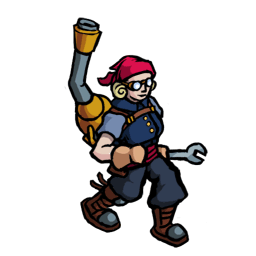
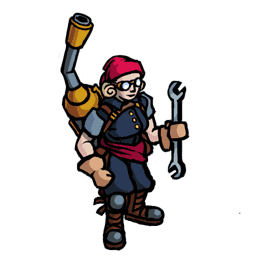
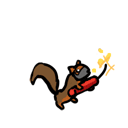
The squirrel is especially charming, and done on a bit of a whim if I recall correctly. The balaclava is a good touch.
The real prize I found is this page from an old sketchbook. (I should mention here: the theme of the game was conflict between a steampunk faction and a magic faction. So, sure, basically the same gimmick as Arcanum.)
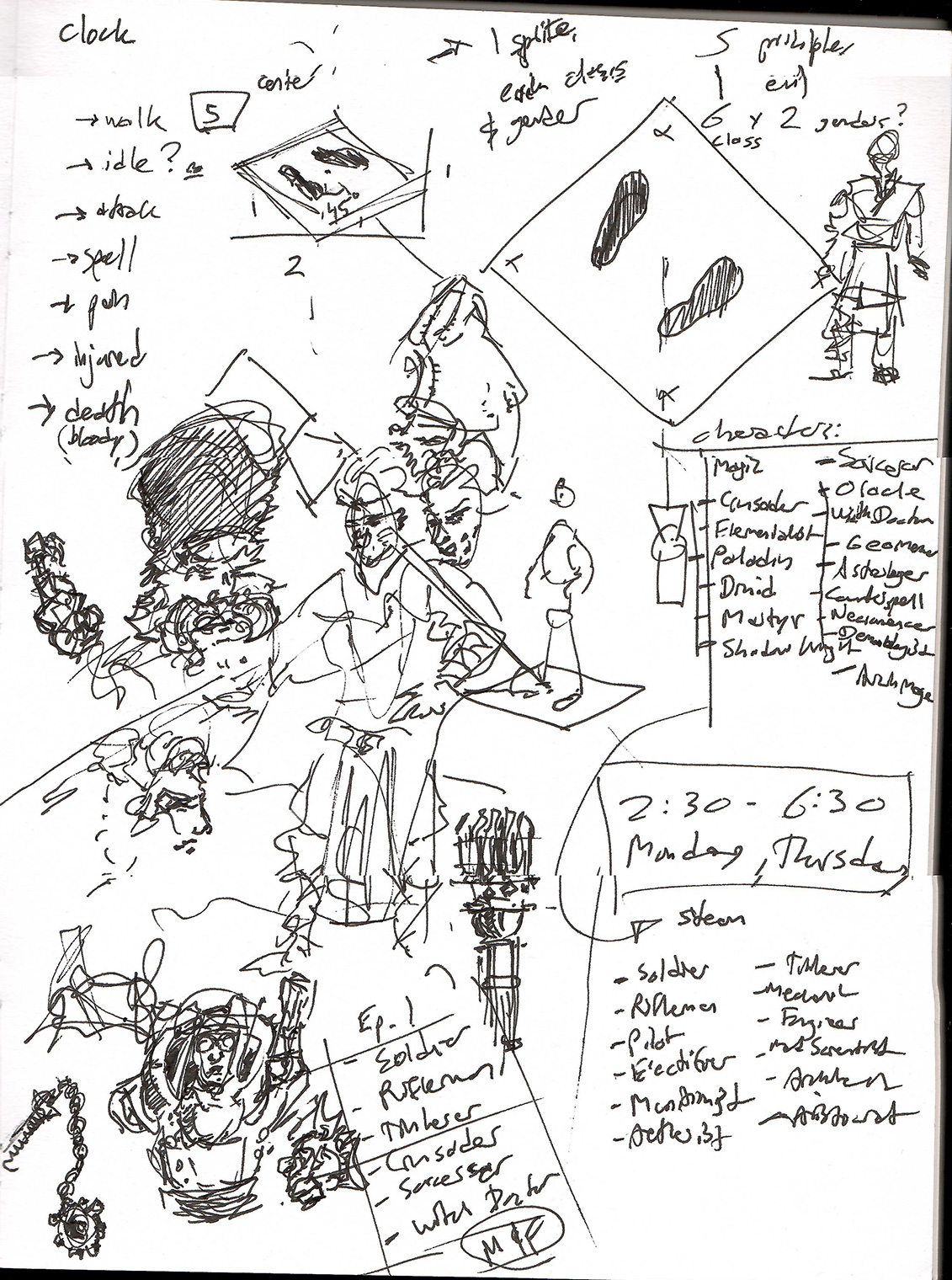
So look closely and you've basically got an outline of my entire contract for the project.
- Upper left: a list of animation sequences per character
- Top center/right: placement of footprints on game tiles
- Also, two genders per class times six classes? I negotiated this contract really poorly
- Center-left: There was some kind of important character that wore a bearskin hat and had a giant mustache, plus a twinky guy with a sword
- Center-right: I can only imagine this was brainstorming for what the magic classes would be for the magic faction, and it wouldn't have been quite all of them. Hopefully.
- Center-right, lower: This appears to be office hours when everyone would be in.
- Bottom-left: Looks like a steam-knight sketch. Maybe he'd wield a cog-morningstar? That's amazing.
- Bottom-center: Episode 1 would only have 3 classes per facton, and two genders per - ah, the 6x2 makes sense now. Still: a ton of work.
- Bottom-right: And here, brainstorming for the steampunk classes.
* * *
Remember Jesse? He was some sort of 3D artist, though not tremendously hard-working from my recollection. He made a few props and put together particle effects and, within a few months, he moved to Japan. We never really heard from him again.
I hope he's doing better.
From how Daniel tells it, Jesse may have taken the project most seriously of all, in some ways - it his alternative to moving back to Japan, apparently, and he wanted to try to finish this game up over the course of the summer of 2008. Clearly, this didn't work out. And there were clearly conversations and plans here that I was not privy to regarding everyone's hopes and intentions - I was, after all, the replacement contract animator.
Wait, replacement? Yes, this brings us to the yam story.
The Yams
As mentioned, I was not the first artist Nicholas recruited.
The artist they'd found before me was fantastically talented, a hundred times better than me at drawing JRPG characters and, presumably, animating them. Though that may be presumbing too much, because she never really did animate anything. And she had other problems; some kind of relationship issue saw her camping out in Nicholas' father's weird basement office for a few weeks before she went off somewhere else without telling anyone. She left behind some instant ramen, a sheef of tracing paper, a light table, a computer full of erotic Sonic the Hedgehog fanart, several yams, and perhaps two beautiful frames of animation. We never heard from her again.
I hope she's doing better.
Business Development at PAX
Daniel and Richard did make that trip to PAX in 2008, though they left their Mega Man arm unfinished in that other half of the basement to outgas its epoxy fumes. Daniel even printed out a stack of confidentiality agreements so that he could talk to publishers about funding our game project, Clockwork Fantasia. We were sure that our game ideas and unique technologies were very important (they weren't), so we had to make sure no one would steal them.
Daniel did not manage to get a single person to sign an NDA, and I do believe he looks back on the whole situation with some embarrassment. One must nonetheless applaud the fact that he put himself out there and tried. I believe he and Richard otherwise drank too much and had lots of fun at PAX.
No business was developed.
The Name Of The Company
Here we come to a point where I'm not entirely sure about the timeline.
To have an NDA, you need some entity who that NDA is being signed with, right? As noted, no one had ever set up a business entity, so I guess the plan was to kinda fudge things with a presumed doing-business-as and some handwaving and a shrug. (Gaslamp Games was legally incorporated in January of 2010, a couple years later - and by then its ownership was split equally three ways between Nicholas, Daniel, and myself. We'll get to that.)
So what was with these NDAs? Did we come up with the name Gaslamp Games to put on the document at this point?
Maybe. I'm not at all sure, and I've lost all of my email correspondance from before 2011 or so. And even then, we probably didn't seriously write anything down. If this was done to set up the NDAs, that would have been sometime during or before August of 2008. If not now, then it'd have been by at most mid-2009.
Let's talk about that name, Gaslamp Games.
* * *
Our method of naming big important things was to brainstorm a list, write down everyone's ideas (two-thirds or more of which would be dumb jokes), then go through a process of voting rounds to whittle that list down to the best candidates then argue it out from there. I don't recall the details, but whatever it was, Gaslamp Games was the result of such a collaborative discussion.
Why "Gaslamp"? Because we thought steampunk was cool. It felt right. Probably because of the alliteration, simple as that.
I do distinctly remember drawing that first series of logos with extra circles and cogs and things around the lamp. (This would all be redone around 2012-2013 into the logo you see more commonly associated with Gaslamp Games. Post-Dredmor release, we wanted to put money into looking like a Serious Business so that we could better secure funding and so on, thus a website overhaul and rebranding in the build up to Clockwork Empires.)
Another Sound? Plan?
Well, the Clockwork Fantasia project rapidly lost inertia.
Jesse wasn't around doing much until he wasn't around at all, I was struggling with animation, though I had worked passably through completion of a couple character sets. I was particularly proud of the Python program I wrote which would shift certain hue ranges of animation frames and save them out as new frames, allowing one supplied character asset set to be turned into eight colours for different 'teams' at the click of a button - anything to do less animation work!
A few more characters:

(Check out the colour ramps on the right - I kept palette very strictly limited so I could process it through my program.)
I may as well introduce you to these characters, from left to right: Witchdoctor, Rune Crusader, Steam Knight, and ... Steam Rifleer or something? And yes, the Witchdoctor and Steam Knight would absolutely re-appear in Clockwork Empires.
* * *
I'll note here that I came into this whole thing as "the artist" and would be credited in that capacity until essentially the end of Gaslamp Games. But I alway had a load of different skills - art of course, but also code, design, writing, ... unneeded historical knowledge... ...obsessive organization of design documents. I think this kept surprising people; I recall during the development of Clockwork Empires, Micah - contract coder who developed the Lua game logic scripting system - expressed admiration that I could code better than most web developers he knew.
It's entirely possible this was a super sick burn on web developers he knew, but I'll take the compliment.
Anyway, "having a bunch of random skills" is a hard sell when you're trying to get people to hire you as a freelancer. It's like, "Oh, so you're mediocre at a bunch of different things? Big deal." But I think there's a counterpoint here in that having cross-discipline ability lets one synthesize those disciplines together - to plan, to manage, to design - with greater insight into what is required from each part and how to bring them together.
... Which is exactly what someone with a fine arts degree in the Frankensteined pseudo-field of "Media Arts" would say, isn't it. And again, no one cares. So I sold myself as "just the artist", and I think that really hampered the other Gaslamp partners impressions and expectations of what I could do. And that limited the recognition I would receive while employing those other skills.
To show the sort of thing I was working on for myself in the period of 2007-2008, here's a personal learning project where I was attempting to create (yes, yes!) my own take on Master of Magic:
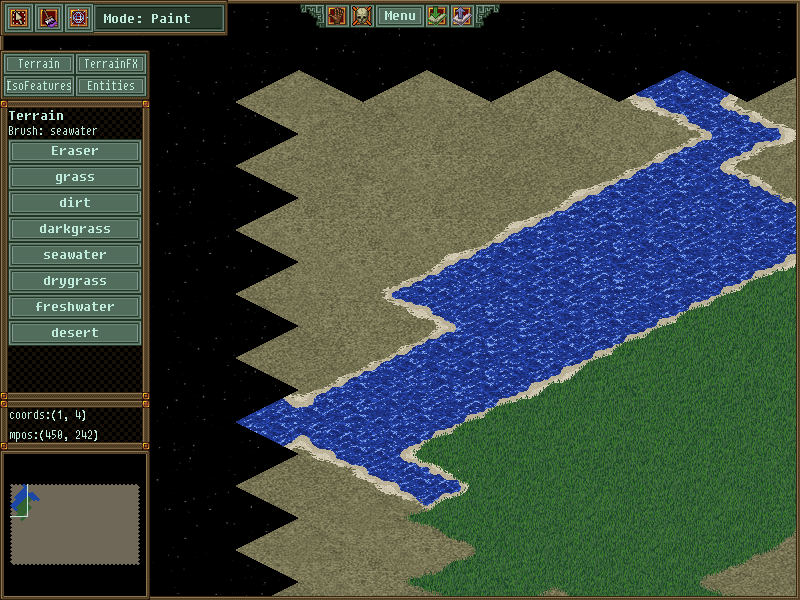
It ended up as basically a map editor and nothing more. But I did make the tiles, the map, a camera system, a UI system, and even font rendering all by myself! I was at the stage of trying to get scrollbars to work when I gave up on the effort, but I learned a great appreciation for UI libraries (to say nothing of font rendering as a standard feature). I swore then that I'd never put myself through this again if it could be helped.
* * *
Back at the ranch, code-side, things were slow going.
That fluid dynamics feature didn't connect with gameplay, and gameplay itself was essentially nonexistent. I believe Nicholas and Daniel did get a character walking around around a 3D tile-map to where you clicked, more or less, using a raycast (I cringe now to think that this can be done in like 3 lines of C# in Unity). And said character could play a shooting animation. I believe there were character stats doing something in the background, and a very complex web of character class upgrades mapped out somewhere. There were some particles. There was some kind of crude physics simulation, though results were consistently erratic.
Like I said, no one ever did sign that NDA, so at least no one in the actual game industry was subjected to any of this.
I suppose it was an impressive product from a newbie team with no real experience. But that doesn't pay rent, does it.
* * *
I remember a game map with a boxy bridge - Jesse modeled that - over a chasm of lava. The character set included the Rune Knight (whose shield ended up in Dredmor), an Engineer with a huge wrench, and the Steam Knight (which would reappear in Clockwork Empires, and whose panoply was added to Dungeons of Dredmor in the third expansion). It wasn't a game though.
And, well. I wasn't getting paid. Jesse moved to Japan. We all had other work to do to make rent. I'm pretty sure Daniel was still finishing his degree. We showed up at the office less often.
* * *
It was a nice walk there, at least.
By then I was living in a basement apartment in the subsection of Victoria called James Bay, a peninsula full of old people with a lovely lighthouse and shoreline park. I'd walk in the morning past the provincial parliament building, past the Empress hotel, across the harbor bridge, and up the hill to Nicholas' father's basement. Victoria was the sort of place where the bus driver recognized me walking this route and stopped the bus to offer me a ride.
"Thanks, I'm good!" I'd say.
The writing was on the wall, though, and everyone knew it.
What Now?
We recognized that maybe Clockwork Fantasia was perhaps a little ambitious. We had to pull our expectations back, make something simple. Maybe something we weren't in love with, but something we could ship. Do that, make some money, and then we could return to finish Clockwork Fantasia. Right?
There were some pitches made in the office: make a rip-off of the OS/2 game "Sherlock". Both Nicholas' father and my mother were really into that same game, for some reason. Portal had come out the year before and blown everyone's minds, and Braid was rocking everyone's notions of indie games just that year; maybe a gimmicky platformer?
(Ah, looking back to then from a world in which the "platformer with a gimmick" is a hilariously overdone indie game dev trope. I swear, there was just something in the water at the time! But no, it really was mostly the aftershocks of Braid, Portal, et al.)
I kinda wanted to remake Master of Magic but, you know, better. Hardly an unambitious undertaking though.
Project Orion
"Ah," I paraphrase Nicholas having said after we showed insufficient enthusiasm for his platformer-with-a-gimmick idea, "I have just the thing. There's this old project I was working on, a roguelike. It's almost done. We can finish it in a couple months!"
Then he showed us "Project Orion" aka "Heroes Wanted" aka "Dungeons of Dredmor".
("Dredmor" is "Mordred" backward, by the way. Ben McGraw came up with the name, so credit to Ben for coming up with a unique string of words that evoked the correct imagery but saddled us forever with people writing "Dreadmor" or "Dredmore" or some other damn thing.)
The following image is not what Nicholas showed us, but rather a screenshot he took of the game before it received the attention of any artist besides himself:
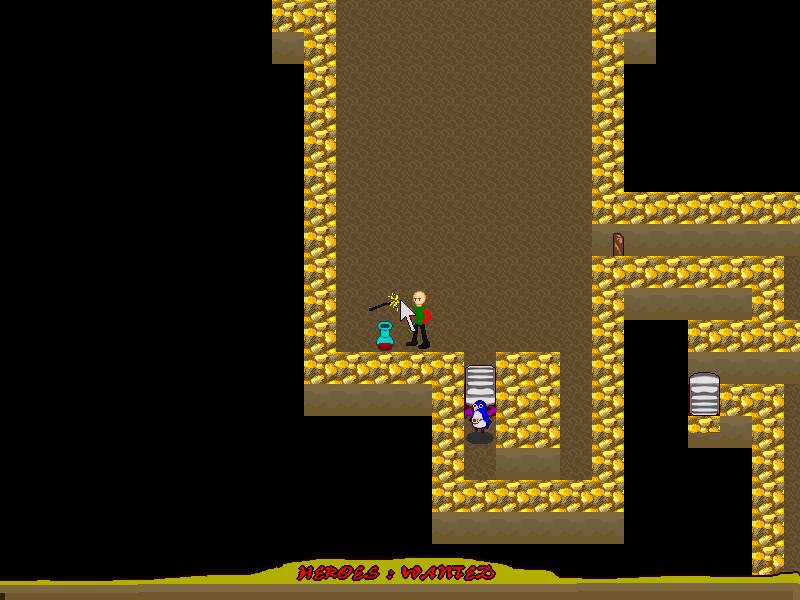
It's the oldest shot of the project that I've got. I'm sure he and others have more.
* * *
Anyway, this thing was not a game. It was a rough almost-game. It did contain most of the elements which, taken together, could resemble a game. Maybe it could work?
What was key was that it had a full set of hero and monster animations completed by Bryan Rathman (who had gone to do other things well before I arrived on the scene; he eventually found his way to a job at Blizzard; good on him). If we were to just polish up graphics, tighten up the UI, figure out the gameplay mechanics, and add an ending we'd be good to go.
Just a month or two of work, ship it, make some cash. No problem.
It was three years later, 2011, that we released Dungeons of Dredmor on Steam.
Why is Guybrush Threepwood kicking that bird from Disgaea?
Let's talk about the starting point of this project, half-baked, when it was shown to me and how that influenced what Dredmor became.
So: The impression I got was that Nicholas wanted to make Quest for Glory as a roguelike, basically.
Quest for Glory and its sequels were a light-hearted series that mixed RPG mechanics with the old adventure game format of the likes of King's Quest. The designers of Quest for Glory never met a groaner of a pun they wouldn't try to shovel in somewhere, and it had that goofy late 80's, early 90's humor aesthetic down pat. Add some generic roguelike mechanics to that, and some whacky JRPG/J-tactics vibes that I've never experienced and didn't understand, hit it with a copy of Terry Pratchett and take a quick glance at Lucas Arts products as Bryan Rathman nods enthusiastically, drop that on the kitchen floor, and what you got was about what Dredmor felt like then.
The character and monster art were done with that sort of tone in mind, so the real question was what can we make with these goofy evil carrots, cute bat things, weird drill-nosed birds ripped off from Disgaea, and this Guybush Threepwood-looking hero?
Pivoting that asset set into something coherent was to be my job.
I went over what was on hand and asked myself: What could I redo? What should be kept? I certainly did not want to touch the animations - not only did Bryan do some very good work, it was a lot of work in a style I was not comfortable imitating.
(Read my lips: no new animation!)
What else have we got? There were a couple tileset environments and some rough item art. Some items were drawn by Bryan, and many were drawn by Nicholas in the original iteration of the game. Despite a spirited effort, he's, ah, not an artist.
The user interface felt like an attempt to re-create the UI of King's Quest. Click on the hand icon to enter "pick up" mode so you can click on something to pick it up (painful), click on the eyeball to examine, etc. It was all to be mouse-driven, so at least this was avoiding the roguelike sin of making every key on the keyboard a hotkey for something different.
The seeds of what defined Dredmor are all here though: humor, graphics, accessibility.
* * *
The plan: I'd redraw the item art, tilesets, and UI into something better and more coherent. Nicholas and Daniel would figure out what was going on with the gameplay mechanics and code it all together.
(At this point "Dredmor" wasn't even a character. We just had a sprite for a lich monster that looked like it could pass for a final boss when the question was raised of what we were going to do for an endgame. "That sprite looks good, that's Dredmor now.")
* * *
On the business side, I don't actually remember a contract - there might have been one, but if that contract existed, I was never paid for it. I assumed this was Nicholas' show, which may not have been totally true, and I think there was a tension felt there. Surely it'd all work itself out quickly enough once the money started flowing, right? The game would start coming together in a matter of weeks, right?
It didn't.
Nicholas and Daniel would argue about how to code one or another thing while I started drawing tiles, so many tiles. And skill icons, and UI layouts. And items. Did we really need 24 spell scrolls? Jeez, that's a lot.
Wait, all the items are drawn in an ancient sprite editing program you pirated from somewhere like ten years ago? No. You need to accept png files.
(Nicholas did this.)
Wait, the particle effects are generated by yet another weird ancient semi-legal program that rendered out enormous piles of frame-by-frame effects of stacked sprites according to a series of arcane parameters set via an awful UI from the early 90's? No. You need to accept png files defined as animation sequences in XML.
(Nicholas did this, eventually.)
We lost inertia, as these things go. People showed up to that dingy basement office less often. I had to focus on my freelance work to pay rent. The usual.
Endings and Beginnings
I had decided I would inform Nicholas that I had to move on. Maybe it was at one of his "bring the weirdest alcohol you can find" holiday parties, maybe it was a different event. Maybe it was a little earlier, or a little later. So I'd say late 2008, but possibly early to mid 2009.
There's a world in which that's how it went, and Dungeons of Dredmor never happened. Nicholas would probably have rustled up some more naive enthusiasts and another project would flag out, the cycle repeating itself until he got a job at a big company as a graphics programmer or something. Daniel hadn't even graduated school yet, so the whole thing was no skin off his back.
But this day was the very day Nicholas - and Daniel? - decided that it was obvious that I would be done with the project unless radical action was taken. So I showed up, and as I was working up the nerve to deliver the bad news, Nicholas said "We want to split ownership three ways."
Well, that was it. That was the one condition that would keep me onboard.
"You got me," I probably said, and that was that.
I mean, not that there actually was a company or a product at that point. Nor was this in writing. But we're committed now.
* * *
During this time - not due to anything with my work at proto-Gaslamp - my long-term relationship fell apart. It was an amicable split, but deeply painful, and I found myself with a giant hole in my own conception of myself and my own future to deal with.
Looking back, I didn't sort my head out until a long, long time after.
It's hard to say how all of this affected my decision-making, what Dredmor meant to me, or how I acted in the context of Gaslamp. But heck, it was hovering there in the background where I bounced between trying to ignore, repress, overcome, and process everything. Looking back, my head was in a weird place. I sure didn't realize it at the time, though.
I did end up moving to Vancouver in the fall of 2009, partly to get myself to a new place away from my dismal basement apartment, partly because I'd met someone there - more on her later. The rest of the company would eventually follow - but we'll get there in due course.
* * *
Whatever is happening now, I'm going to make Dungeons of Dredmor for real.
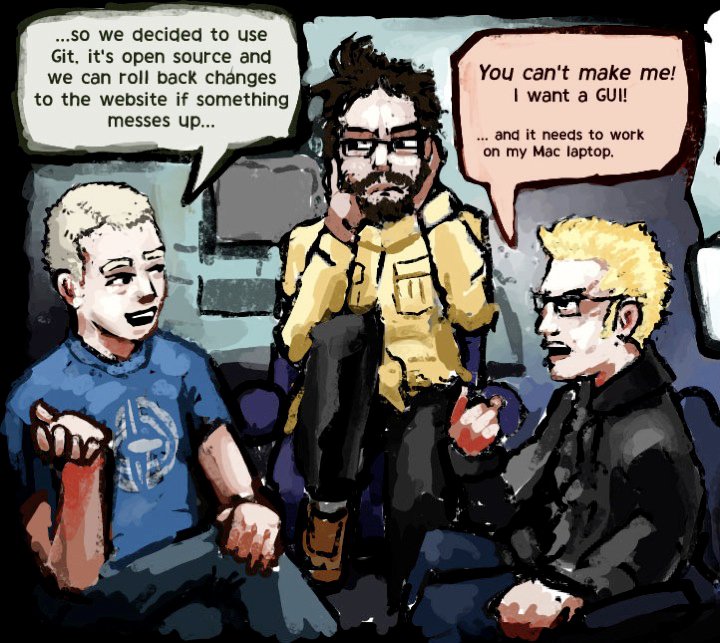
(A panel from a comic I drew, probably from early 2010 due to subject matter. Left to right: Daniel, Nicholas, and myself.)
Part 2 is "Developing Dungeons of Dredmor"
Return to blog index